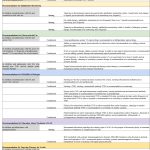A group led by Sarah Ringold, MD, MS, assistant professor of rheumatology at Seattle Children’s Hospital, has developed a new guideline intended to provide recommendations for the treatment and monitoring of children with juvenile idiopathic arthritis (JIA) manifesting as non-systemic polyarthritis, sacroiliitis or enthesitis.1,2
Key Updates
The new recommendations appear in both Arthritis & Rheumatology and Arthritis Care & Research, alongside a new guideline for JIA-associated uveitis.3,4 They are intended to make decision making less complex for physicians, caregivers and patients, and provide updates to recommendations published by the ACR in 2011, reflecting new data and therapeutic options.
One example: “NSAID [non-steroidal anti-inflammatory drug] monotherapy is no longer recommended given the established benefits of early DMARD [non-biologic and biologic disease-modifying anti-rheumatic drug] treatment,” says Dr. Ringold.
The updates take advantage of the Grading of Recommendations Assessment, Development and Evaluation (GRADE), rigorous methodology that involves a more transparent decision-making process relative to methodologies previously used for ACR JIA guidelines. GRADE balances harms and benefits, provides well-defined criteria for translating evidence to recommendations, and incorporates patient preferences and values.
Recommendation Process
The process involved numerous physicians, patients and the parents of children with JIA. Because most of the supporting evidence available to the team was of low or very low quality, according to GRADE standards, the recommendations explicitly call for shared decision making between providers and parents.
“The inclusion of patient and parent preferences unquestionably adds value to the new recommendations because many of the recommendations are based on limited evidence,” says pediatric rheumatologist and guideline co-author, Tim Beukelman, MD, MSCE.
The new recommendations should also help direct future research agendas and emphasize the ongoing need for high-quality data regarding treatment effectiveness, particularly to fill gaps in the data, says Dr. Ringold. Due to these gaps, the new guideline does not address a number of treatment questions providers face, including the management of inactive disease in JIA and the tapering or withdrawal of medications.
However, it offers 39 recommendations: eight strong and 31 conditional, including specific recommendations for polyarthritis (five joints or more) that involve general medication use, adjunctive therapies and good disease control. Sacroiliitis and enthesitis recommendations are focused on initial and adjunctive therapies.
Strong recommendations are those for which the guideline voting panel was confident the benefits of the action outweigh the risks and would apply to most or all patients. Conditional recommendations are those for which the voting panel had less confidence in the risk–benefit assessment, with a preference for shared decision making. The team also considered outcomes, such as pain, disease activity, quality of life and joint damage.
Notably, the guideline highlights the importance of early treatment to prevent disability and joint damage, and provides recommendations for escalating care for low disease activity to maintain complete disease control, says Dr. Ringold.
“The recommendation for escalation of therapy in patients with polyarthritis and low disease activity affirms that active arthritis should not simply be tolerated,” explains Dr. Beukelman, who led the ACR’s 2011 JIA guideline development process.
Polyarthritis Recommendations
Initially, the core team wanted to categorize patients into treatment groups based on risk factors for the disease and disease activity, but lacked available data to do so. The recommendations are organized around a set of questions called patient/population, intervention, comparison and outcomes (PICO).
For general medications:
- NSAIDs are conditionally recommended as adjunct therapy.
- Methotrexate is conditionally recommended over leflunomide or sulfasalazine, based on lack of data, difficulty of leflunomide administration in young children and safety concerns for sulfasalazine. Subcutaneous methotrexate is conditionally recommended over oral methotrexate.
- Several recommendations involve the use and administration of glucocorticoids, including the use of intra-articular glucocorticoids as adjunct therapy—with a strong recommendation for triamcinolone hexacetonide use over triamcinolone acetonide; conditional recommendation of oral glucocorticoids as bridging therapy during initiation or escalation of therapy in patients with high or moderate disease activity (course of three months or less to control disease activity during initiation or escalation of therapy); and a strong recommendation against adding chronic low-dose glucocorticoid, regardless of risk factors or disease activity.
- Several recommendations involve biologic DMARDs, with recommendations for combination therapies with drugs including etanercept and tocilizumab over biologic monotherapy, and a strong recommendation for DMARD combination therapy with infliximab.
- A conditional recommendation is for the use of physical therapy and/or occupational therapy in children and adolescents with JIA and polyarthritis with or at risk of functional limitations.
For initial and subsequent treatment:
- For all patients, DMARD therapy is strongly recommended over NSAID monotherapy, and methotrexate monotherapy is conditionally recommended over triple DMARD therapy (for initial treatment).
- DMARDs are conditionally recommended as initial therapy over a biologic for patients without risk factors (including positive anti-cyclic citrullinated peptide antibodies).
- In patients with risk factors, unless a biologic is preferred, a DMARD should precede biologics for initial therapy. Biologics should be considered for patients with risk factors and high-risk joint involvement or high disease activity, or who are at high risk for developing disabling joint damage.
- Conditional recommendations are for the escalation of therapy for children with low disease activity receiving a DMARD and/or biologics, which could include a trial of methotrexate.
- Recommendations for children with moderate to high disease activity, receiving DMARD monotherapy are to add a biologic to the original DMARD over changing to a second DMARD or changing to triple DMARD therapy, or for children receiving their first tumor necrosis factor (TNF) inhibitor to switch to a non-TNF inhibitor. A biologic is conditionally preferable to switching to a second TNF inhibitor. Abatacept or tocilizumab may be preferable to rituximab.
Sacroiliitis Recommendations
To be considered active sacroiliitis, the guideline says, JIA patients must report symptoms of inflammatory back pain or have a positive magnetic resonance imaging (MRI) scan and clinical exam.
For initial and subsequent treatment:
- NSAIDs are strongly recommended over no treatment in active sacroiliitis, and a TNF inhibitor is strongly recommended for patients with active sacroiliitis despite NSAIDs over NSAID monotherapy. A conditional recommendation is to use sulfasalazine in patients who cannot tolerate or don’t respond to a TNF inhibitor and a strong recommendation against methotrexate monotherapy.
- Conditional guidance is provided to use bridging therapy with a limited (less than three-month) course of oral glucocorticoids during initiation or escalation of therapy in children and adolescents with active disease despite NSAID treatment or intraarticular glucocorticoid injection into the sacroiliac joints as conditional adjunct therapy.
- A conditional recommendation is to use physical therapy in children with or at risk for functional limitations.
Enthesitis Recommendations
JIA patients with enthesitis have inflammation at tendon-to-bone insertion sites, defined as tenderness or swelling.
For initial and subsequent treatment:
- NSAID therapy is strongly recommended in children and adolescents with active enthesitis over no NSAID treatment, and a TNF inhibitor is strongly recommended for patients with active sacroiliitis despite NSAIDs over methotrexate or sulfasalazine. A limited course of oral glucocorticoids (fewer than three months) is conditionally recommended as bridging therapy during initiation or escalation of treatment, particularly in cases of high disease activity, limited mobility and/or significant symptoms.
- A conditional recommendation is made for physical therapy in patients at risk for functional limitations.
An Evolving Science
The JIA guideline addresses specific phenotypes of the disease, Dr. Ringold says, although “JIA is an umbrella term. Understanding of the underlying biology of JIA is evolving, and ideally, future recommendations will align with some of that biology more specifically.”
For now, she emphasizes, “Given the conditional nature of most of these recommendations, treatment decisions still require shared decision making between patients and providers.”
Kelly April Tyrrell writes about health, science and health policy. She lives in Madison, Wis.
References
- Ringold SR, Angeles-Han ST, Beukelman T, et al. 2019 American College of Rheumatology/Arthritis Foundation guideline for the treatment of juvenile idiopathic arthritis: Therapeutic approaches for non-systemic polyarthritis, sacroiliitis, and enthesitis. Arthritis Care Res.2019 Apr 25. doi: 10.1002/acr.23870. [Epub ahead of print]
- Ringold SR, Angeles-Han ST, Beukelman T, et al. 2019 American College of Rheumatology/Arthritis Foundation guideline for the treatment of juvenile idiopathic arthritis: Therapeutic approaches for non-systemic polyarthritis, sacroiliitis, and enthesitis. Arthritis Rheumatol. 2019 Apr 25. doi: 10.1002/art.40884. [Epub ahead of print]
- Angeles-Han ST, Ringold SR, Beukelman T, et al. 2019 American College of Rheumatology/Arthritis Foundation guideline for the screening, monitoring, and treatment of juvenile idiopathic arthritis-associated uveitis. Arthritis Care Res(Hoboken).2019 Apr 25. doi: 10.1002/acr.23871. [Epub ahead of print]
- Angeles-Han ST, Ringold SR, Beukelman T, et al. 2019 American College of Rheumatology/Arthritis Foundation guideline for the screening, monitoring, and treatment of juvenile idiopathic arthritis-associated uveitis. Arthritis Rheumatol. 2019 Apr 25. doi: 10.1002/art.40885. [Epub ahead of print]


